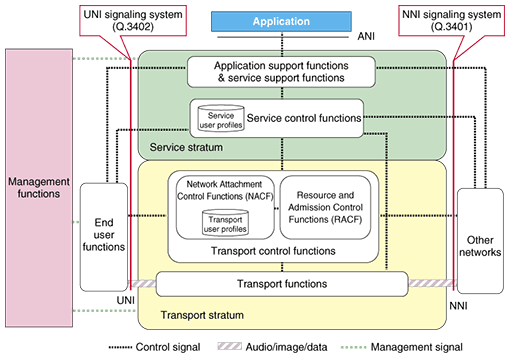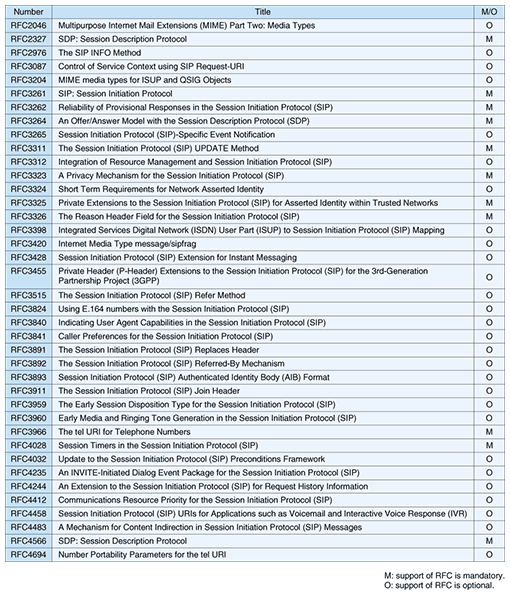 |
|||||||||||||||||
|
|
|||||||||||||||||
|
Global Standardization Activities Vol. 7, No. 2, pp. 35–39, Feb. 2009. https://doi.org/10.53829/ntr200902gls Standardization Trends in ITU-T NGN UNI and NNI SignalingAbstractThe International Telecommunication Union, Telecommunication Standardization Sector (ITU-T) released the Recommendations for Next Generation Network (NGN) signaling for the Network Network Interface (NNI) and the User Network Interface (UNI) in March 2007 and February 2008, respectively. Consequently, the specifications for basic communications of session-oriented services are now ready. This paper overviews the NGN signaling for UNI and NNI in ITU-T.
1. Scope of NGN signalingThe first set of ITU-T (International Telecommunication Union, Telecommunication Standardization Sector) Recommendations for the Next Generation Network (NGN), called NGN Release 1, aims to provide interactive multimedia communication services (session-oriented services) based on audio and video between two parties [1], [2]. As part of NGN Release 1, the Recommendations for NGN signaling for the Network to Network Interface (NNI) and the User to Network Interface (UNI) were specified in March 2007 and February 2008, respectively. The NNI is the interface to other NGN operators and the UNI is the interface to terminals. They are defined in the NGN architecture of Y.2012 (Fig. 1) [3].
Those signaling Recommendations specify control signals that handle the setup and release of sessions. They also specify audio and video used during the communication, such as recommended codecs to be used, because the information, e.g., types of audio and video for session-oriented communications, is negotiated over control signals at the time of session setup. 2. Specifications of NGN signalingThe control signals of session-oriented services over the NGN use the session initiation protocol (SIP), which is specified by the Internet Engineering Task Force (IETF), the Internet-related standards developing organization. SIP defines a communication that lasts for a definite period of time over IP (Internet protocol) networks as a session and provides various control functions including session setup and release as well as registration of terminals with the network. When we say “SIP” in IETF, its specifications in IETF cover a wide range of functionalities, as is obvious from the fact that more than one hundred documents have been specified since the first publication of RFC3261 [4] in 2002, which specifies very basic procedures for SIP. However, it is not necessary to implement all of these specifications to provide session-oriented services over the NGN. Moreover, in the SIP specifications in IETF, there is a lot of room for choosing options to cover general usages. Therefore, it is necessary to sort out specifications, i.e., to perform profiling, in order to improve interoperability or make implementations easy. Consequently, the profile for applying the SIP specifications to the NGN NNI is specified in Q.3401, and that for the UNI is specified in Q.3402. Specifically, these profiles include distinctions between mandatory (M) and optional (O) support for the document (Request for Comments (RFC)) and for messages and parameters and include clarifications and choices of options within the RFCs. The mandatory and optional distinctions at the document (RFC) level as part of the profile of the NNI in Q.3401 are listed in Table 1.
The contents of Q.3401 and Q.3402 resemble each other because SIP can be applied to both the UNI and NNI, but there are differences between them. One example is the network-asserted calling party ID (identification), which is certainly forwarded between networks, but is not configurable at the originating UNI and must be forwarded to the user at the destination UNI if the calling party ID presentation is configured. Additionally, Q.3401 and Q.3402 define Real-time Transport Protocol (RTP) profiles, which are used for audio and video between users, and codecs recommended to be used. However, Q.3401 and Q.3402 do not specify implementations of terminals themselves, but only the signaling over the reference points—the NNI and UNI. Therefore, the codecs that are actually used in communications are determined by end-to-end negotiation at the time of session setup. A list of codecs recommended to be configured in the session setup signals for this negotiation is specified (Table 2).
Furthermore, as the reference point between the NGN and applications in the NGN architecture in Y.2012, the Application Network Interface (ANI) is defined as well as the NNI and UNI, as shown in Fig. 1. Y.2001 states that open APIs, e.g., Parlay-X, should be provided over the ANI. Currently, application support functions and service support functions are under study to enable the ANI specifications to be completed. 3. Relationship with 3GPP and ETSI TISPANThe 3rd Generation Partnership Project (3GPP) and ETSI TISPAN (European Telecommunication Standards Institute, Telecoms & Internet converged Services & Protocols for Advanced Network)) also specify the SIP profiles in the detailed internal structure of the IP Multimedia Subsystem (IMS) and the NGN [5], [6]. ITU-T focuses on the reference points between the NGN and its externals from the interoperability viewpoints while referencing 3GPP and TISPAN specifications. More precisely, the specifications of ITU-T are closely related to interconnections between NGNs or between NGN and users, and those of 3GPP/ETSI TISPAN to implementations of function blocks constructing the NGN. Therefore, the two specifications have compatibility with and complement one another, without any mutual duplication or contradiction. In the standardization activities at ITU-T, once a Recommendation has been issued, it is not modified frequently because completeness is fully achieved before publication. However, at 3GPP/ETSI TISPAN, documents are published when they achieve certain levels of completeness; thereafter, amendments are issued repeatedly as necessary. Policies for revising documents are considerably different in these standardization bodies. Q.3401 (NNI) and Q.3402 (UNI) were specified with sufficient consistency with the 3GPP and ETSI/TISPAN specifications at the time of their publication by ITU-T. 4. Relationship with domestic standardization activitiesThe Telecommunications Technology Committee in Japan (TTC) issued two technical reports, TR-9025 and TR-9024 [7], based on existing standards for operators’ SIP networks, but not for NGN, ahead of ITU-T. These corresponded to the NNI and UNI respectively, with limited functions. The NNI was already standardized as JT-Q.3401 at TTC following publication at ITU-T in 2007 and the UNI was scheduled to be done in 2008. These TTC standards, which are downstream from ITU-T Recommendations, adhere directly to the contents in the previous technical reports issued, and they enhance the functionalities so that they conform to the NGN architecture perfectly. 5. Future activitiesThe NGN signaling in ITU-T first specifies the NNI and UNI for basic session-oriented services. NTT Laboratories has proactively contributed to ITU-T for the international standardization and downstreaming of ITU-T Recommendations to TTC. These specifications are very important for providing various services of NTT’s NGN and for interconnecting to other carriers’ NGNs and user terminals. All the various NGN services provided by NTT fully conform to the ITU-T Recommendations regarding NGN signaling, e.g., Q.3401, and the corresponding TTC standards. ITU-T is studying more advanced services than the basic session-oriented services, for example, customized ringback tones and ringing tones. Based on its pioneering experiences in Japan’s broadband environment, NTT Laboratories will continue to contribute to NGN international standardization. References
|
|||||||||||||||||












